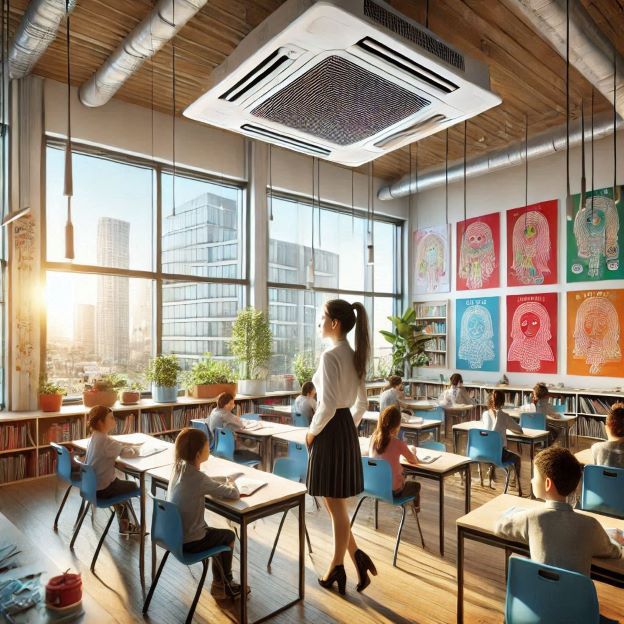From Science Classrooms to Sustainable Solutions: Educational Tools in Ventilation and Heating

Schools have a unique opportunity to teach students practical, real-world applications by integrating HVAC (Heating, Ventilation, and Air Conditioning) concepts into STEM lessons. These systems are essential for creating comfortable, energy-efficient, and sustainable environments. Teaching students about HVAC can connect science lessons to real-world problem-solving and sustainability.
Understanding the Importance of HVAC Systems
HVAC systems control air quality, heating, and cooling in buildings. They manage how air moves, regulate temperature, and filter out contaminants to improve indoor air quality. Learning about these systems allows students to connect science with environmental sustainability. Practical education with HVAC topics prepares students for engineering, sustainability, and technology careers.
Wholesale HVAC system solutions are important for real-world applications and commercial use. Schools can learn how these systems contribute to energy efficiency and environmental conservation. A wholesale trading company in Belgium like Groothandel (groothandel.be) can connect students with real-world examples of HVAC systems. This connection provides insights into how HVAC systems are scaled for industries and how they impact sustainability.
Integrating HVAC Concepts into STEM Education
Science, Technology, Engineering, and Mathematics (STEM) programs thrive on problem-solving and innovation. Schools can enhance these programs by introducing HVAC systems as a learning tool. These systems combine physics, engineering, environmental science, and real-world application into a hands-on learning experience.
1. Physics of Airflow and Heat Transfer
Students can explore how heat moves and how airflow works through HVAC principles. Concepts like convection, conduction, and radiation can be demonstrated through practical experiments. Hands-on lessons could include:
- Observing heat transfer between different surfaces.
- Building simple air movement models.
- Exploring the relationship between air pressure, temperature, and movement.
These experiments make physics fun and relatable by connecting lessons to real-world applications.
2. Engineering and HVAC Design Projects
Students can learn about system design by creating models or prototypes. Hands-on engineering projects can teach students how HVAC systems function and how they are built to provide sustainable solutions. Projects could include:
- Designing small ventilation systems.
- Simulating energy-saving methods.
- Creating models using HVAC design software.
These design projects teach collaboration, problem-solving, and the application of engineering principles.
3. Environmental Science and Sustainability
HVAC systems also align with environmental goals. They can help students explore energy consumption and its effects on climate change. Schools can incorporate lessons on:
- Renewable energy and HVAC integration.
- Sustainable materials and how they contribute to energy-efficient designs.
- How air purification systems reduce pollutants and contribute to a cleaner environment.
These insights encourage students to think critically about environmental sustainability.
Hands-On Experiments with Ventilation and Heating
Science classrooms can implement fun, hands-on experiments related to ventilation and heating. These experiments can teach students about airflow, energy efficiency, and air quality. Some simple experiments include:
– Building DIY Ventilation Models
Using cardboard, fans, and air vents, students can create simple air circulation systems to study airflow patterns.
– Heat Transfer with Everyday Materials
Students can test different materials for their ability to retain or dissipate heat. For example, testing how metals or insulation materials affect heat transfer.
– Analyzing the Impact of Air Quality
Monitoring classroom air quality using small sensors to explore how air quality affects health and energy use.
These experiments make science hands-on, engaging, and practical.
Preparing Students for Careers in HVAC and Sustainability
Teaching HVAC principles prepares students for various career paths. With the demand for sustainable solutions rising, careers in HVAC systems design, environmental engineering, and energy management are becoming vital. Exposure to these concepts in classrooms provides students with foundational knowledge for future career opportunities.
Exploring Skills Students Gain
By studying HVAC systems, students can learn skills such as:
- Problem-solving and engineering design.
- Understanding energy efficiency and conservation.
- Applying mathematics to real-world systems.
These skills are transferable to many industries and align with future employment opportunities.
Partnerships with Industry Experts
Collaborations with local companies like wholesale trading companies like Groothandel allow students to connect theoretical learning with industry experience. Guest speakers, company tours, and partnerships with local businesses provide hands-on insights into real-world applications.
Collaborations allow students to:
- Learn from industry experts.
- Gain insights into cutting-edge HVAC technologies.
- Understand how these technologies impact daily life and environmental change.
These partnerships broaden student perspectives and inspire innovation in the classroom.
READ ALSO: Classrooms Need Natural Light For Effective Learning Environment
Conclusion
Integrating HVAC concepts into science classrooms can bridge the gap between academic learning and real-world application. From exploring airflow and heat transfer to designing energy-efficient solutions, students gain valuable knowledge that empowers them to think critically about sustainability. Partnerships with companies like Groothandel and hands-on projects prepare students for future careers while fostering creativity and problem-solving.
With these educational tools, schools can prepare students for the challenges of tomorrow while making learning exciting and relevant.
